Effect of Performance by Excessive Advanced Fuel Injection Timing on Marine Diesel Engine
Abstract
:1. Introduction
2. Methods
2.1. Experimental Methods
- The flywheel’s TDC mark and the piston’s TDC did not align, and the fuel injection timing was adjusted based on the flywheel TDC mark of each cylinder.
- While diesel engines with 6 or more cylinders could start at any crank angle, the target engine had a specific crank angle, where air running was not possible. Therefore, it was set to turn after the TDC mark by 10 °CA before attempting to start the engine.
- Two to 3 failed start attempts occurred before the transition to fuel running. This phenomenon was more pronounced when the engine’s preheating was insufficient.
- Compared to other engines, the target engine exhibited more vibration and noise, especially a dull noise, such as knocking during no-load (idling) operation.
2.2. Calculation of Rate of Heat Release and Turning Force of the Crankshaft
3. Results
3.1. Diagnostics and Solutions with Engine Combustion Analysis
3.1.1. Diagnostics
3.1.2. Solutions
- The flywheel TDC mark was positioned 4.5 °CA ahead of the actual TDC.
- The fuel injection timing was more advanced than that of a typical 4-stroke medium-speed diesel engine.
- Due to excessively advanced fuel injection timing, ignition and Pmax occurred BTDC. This resulted in increased compression work and the occurrence of reverse torque. The dull noise and vibration observed in the engine are believed to have been caused by these combustion phenomena.
- The fuel injection timing was retarded by 6–7 °CA.
- By adjusting the fuel injection timing between each cylinder, the ignition timing of all cylinders converged within a range of 1 °CA.
- The fuel injection quantity was adjusted to ensure that the output deviation of each cylinder was within a range of 3%.
3.2. Before-and-after Comparison of Engine Adjustments
4. Discussion
5. Conclusions
- The engine’s starting fail, dull noise, and vibrations were attributed to excessively advanced fuel injection, resulting in premature ignition and peak pressure occurring before TDC, as well as significant variations in Pmax height among cylinders.
- By retarding the injection timing by approximately 10 degrees, Pmax decreased by up to 15 bar and the ignition timing was delayed by 6.5 degrees.
- Excessively advanced ignition reduced the work performed during the cycle by increasing compression work and decreasing expansion work.
- Excessively advanced ignition and large variations in Pmax led to significant fluctuations in the crankshaft’s angular velocity, causing engine vibrations.
Author Contributions
Funding
Institutional Review Board Statement
Informed Consent Statement
Data Availability Statement
Conflicts of Interest
References
- Chang, H.; Zhang, Y.; Chen, L. An applied thermodynamic method for correction of TDC in the indicator diagram and its experimental confirmation. Appl. Therm. Eng. 2005, 25, 759–768. [Google Scholar] [CrossRef]
- Stas, M.J. Thermodynamic Determination of TDC in Piston Combustion Engines; Society of Automotive Engineers, Inc.: Warrendale, PA, USA, 1996. [Google Scholar]
- Staś, M.J. An Universally Applicable Thermodynamic Method for TDC Determination; SAE Technical Paper 0148-7191; SAE: Warrendale, PA, USA, 2000. [Google Scholar]
- Morishita, M.; Kushiyama, T. An Improved Method of Determining the TDC Position in a PV-Diagram; SAE Technical Paper 0148-7191; SAE: Warrendale, PA, USA, 1998. [Google Scholar]
- Pipitone, E.; Beccari, A. Determination of TDC in internal combustion engines by a newly developed thermodynamic approach. Appl. Therm. Eng. 2010, 30, 1914–1926. [Google Scholar] [CrossRef] [Green Version]
- Varbanets, R.A.; Zalozh, V.I.; Shakhov, A.V.; Savelieva, I.V.; Piterska, V.M. Determination of top dead centre location based on the marine diesel engine indicator diagram analysis. Diagnostyka 2020, 21, 51–60. [Google Scholar] [CrossRef]
- Pawletko, R.; Polanowski, S. Influence of TDC determination methods on mean indicated pressure errors in marine diesel engines. J. KONES 2011, 18, 355–363. [Google Scholar]
- Lee, J.; Jung, G.-S.; Lee, W.-J. Causes of Top Dead Center Error in Marine Generator Engine Power-Measuring Device. J. Korean Soc. Mar. Environ. Saf. 2020, 26, 429–435. [Google Scholar] [CrossRef]
- Eder, L.; Kiesling, C.; Priesching, P.; Pirker, G.; Wimmer, A. Multidimensional Modeling of Injection and Combustion Phenomena in a Diesel Ignited Gas Engine; SAE Technical Paper 0148-7191; SAE: Warrendale, PA, USA, 2017. [Google Scholar]
- Kim, H.J.; Park, S.H.; Lee, C.S. Impact of fuel spray angles and injection timing on the combustion and emission characteristics of a high-speed diesel engine. Energy 2016, 107, 572–579. [Google Scholar] [CrossRef]
- Saravanan, S.; Nagarajan, G.; Lakshmi Narayana Rao, G.; Sampath, S. Theoretical and experimental investigation on effect of injection timing on NOx emission of biodiesel blend. Energy 2014, 66, 216–221. [Google Scholar] [CrossRef]
- Kannan, G.R.; Anand, R. Effect of injection pressure and injection timing on DI diesel engine fuelled with biodiesel from waste cooking oil. Biomass Bioenergy 2012, 46, 343–352. [Google Scholar] [CrossRef]
- Vadlamudi, S.; Gugulothu, S.K.; Panda, J.K.; Deepanraj, B.; Kumar, P.R.V. Paradigm analysis of performance and exhaust emissions in CRDI engine powered with hydrogen and Hydrogen/CNG fuels: A green fuel approach under different injection strategies. Int. J. Hydrogen Energy 2022. [Google Scholar] [CrossRef]
- Nwafor, O.M.I.; Rice, G.; Ogbonna, A.I. Effect of advanced injection timing on the performance of rapeseed oil in diesel engines. Renew. Energy 2000, 21, 433–444. [Google Scholar] [CrossRef]
- Park, H.; Shim, E.; Lee, J.; Oh, S.; Kim, C.; Lee, Y.; Kang, K. Large–squish piston geometry and early pilot injection for high efficiency and low methane emission in natural gas–diesel dual fuel engine at high–load operations. Fuel 2022, 308, 122015. [Google Scholar] [CrossRef]
- Varbanets, R.; Alexandrovskaya, N.; Golovan, A.; Kucherenko, Y.N. Experimental trial of VIT system of the low-speed diesel MAN 6l80MCE. Vestn. Astrakhan State Tech. Univ. Ser. Mar. Eng. Technol. 2013, 2013, 85–92. [Google Scholar]
- Zhang, M.; Zi, Y.; Niu, L.; Xi, S.; Li, Y. Intelligent Diagnosis of V-Type Marine Diesel Engines Based on Multifeatures Extracted From Instantaneous Crankshaft Speed. IEEE Trans. Instrum. Meas. 2019, 68, 722–740. [Google Scholar] [CrossRef]
- Çelik, V.; Arcaklioğlu, E. Performance maps of a diesel engine. Appl. Energy 2005, 81, 247–259. [Google Scholar] [CrossRef]
- Moussa Nahim, H.; Younes, R.; Shraim, H.; Ouladsine, M. Modeling with Fault Integration of the Cooling and the Lubricating Systems in Marine Diesel Engine: Experimental validation. IFAC-PapersOnLine 2016, 49, 570–575. [Google Scholar] [CrossRef]
- Çay, Y.; Çiçek, A.; Kara, F.; Sağiroğlu, S. Prediction of engine performance for an alternative fuel using artificial neural network. Appl. Therm. Eng. 2012, 37, 217–225. [Google Scholar] [CrossRef]
- Basurko, O.C.; Uriondo, Z. Condition-Based Maintenance for medium speed diesel engines used in vessels in operation. Appl. Therm. Eng. 2015, 80, 404–412. [Google Scholar] [CrossRef]
- Jung, K.S.; Lee, S.K. System for Measuring Output of Large-Sized Low-Speed Two-Stroke Engine and Method for Measuring Output of Large-Sized Low-Speed Two-Stroke Engine. European Patent EP3561271B1, 12 January 2022. [Google Scholar]
- Jung, K.S.; Lee, S.K. Combustion Analysis Apparatus for Large-Sized Low-Speed Engine and Method for Determining Combustion State of Engine Using the Same. European Patent EP3561475B1, 31 March 2021. [Google Scholar]
- Yokogawa Test & Measurement Corporation. Combustion Pressure Analysis Software (for Diesel); IM 720340-02EN; Yokogawa Test & Measurement Corporation: Tokyo, Japan, 2019. [Google Scholar]
- Marine Engineers Knowledge. Available online: https://www.marineengineersknowledge.com/2022/02/fuel-pump-timing-adjustment-in-marine.html (accessed on 7 July 2023).
- Hountalas, D.T.; Sakellaridis, N.F.; Pariotis, E.; Antonopoulos, A.K.; Zissimatos, L.; Papadakis, N. Effect of Turbocharger Cut Out on Two-Stroke Marine Diesel Engine Performance and NOx Emissions at Part Load Operation. In Proceedings of the ASME 2014 12th Biennial Conference on Engineering Systems Design and Analysis, Copenhagen, Denmark, 25–27 June 2014. [Google Scholar]
- Tufte, E.D. Impacts of Low Load Operation of Modern Four-Stroke Diesel Engines in Generator Configuration. Master’s Thesis, Institutt for Marin Teknikk, Trondheim, Norway, 2014. [Google Scholar]
- Charchalis, A.; Dereszewski, M. Processing of instantaneous angular speed signal for detection of a diesel engine failure. Math. Probl. Eng. 2013, 2013, 659243. [Google Scholar]

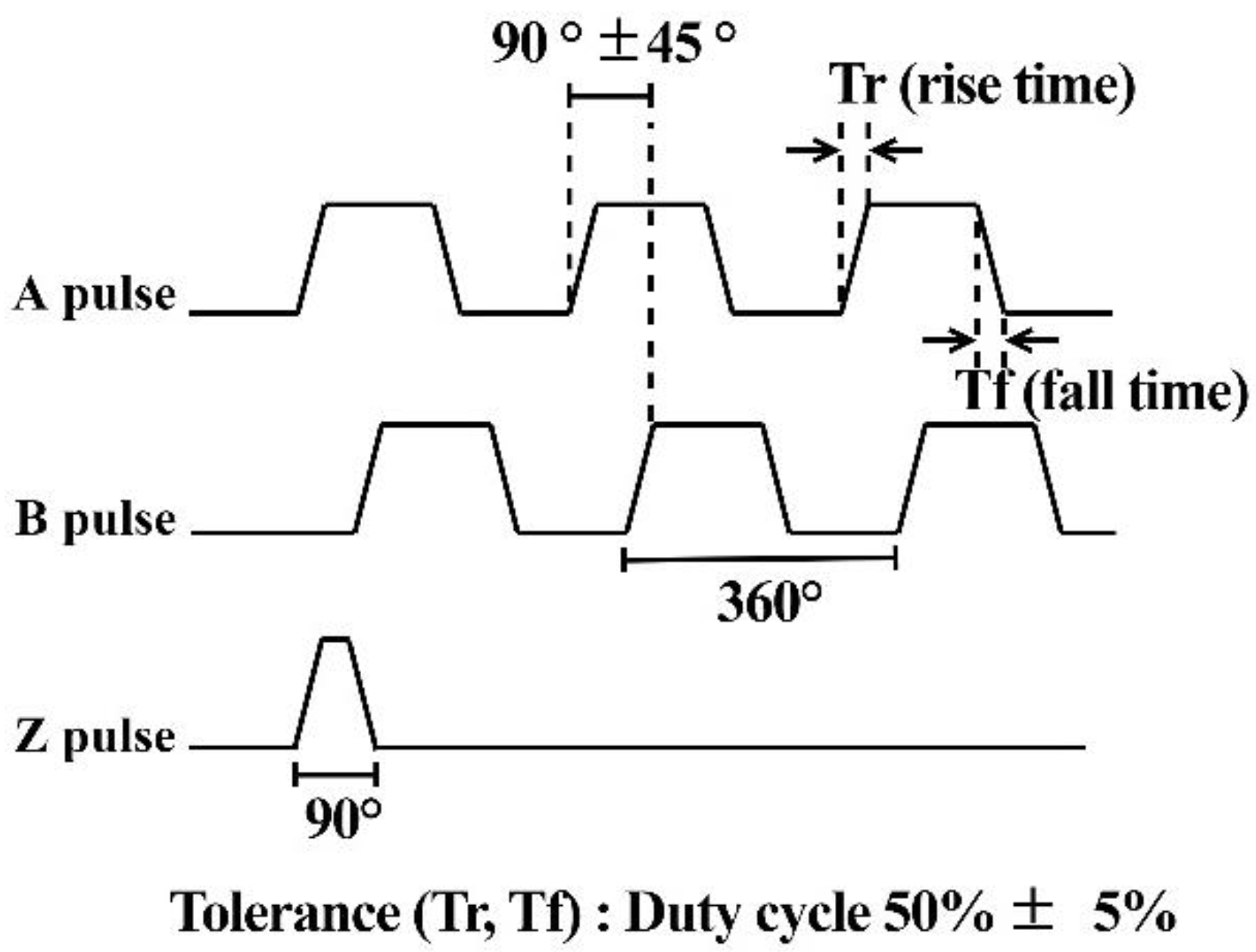


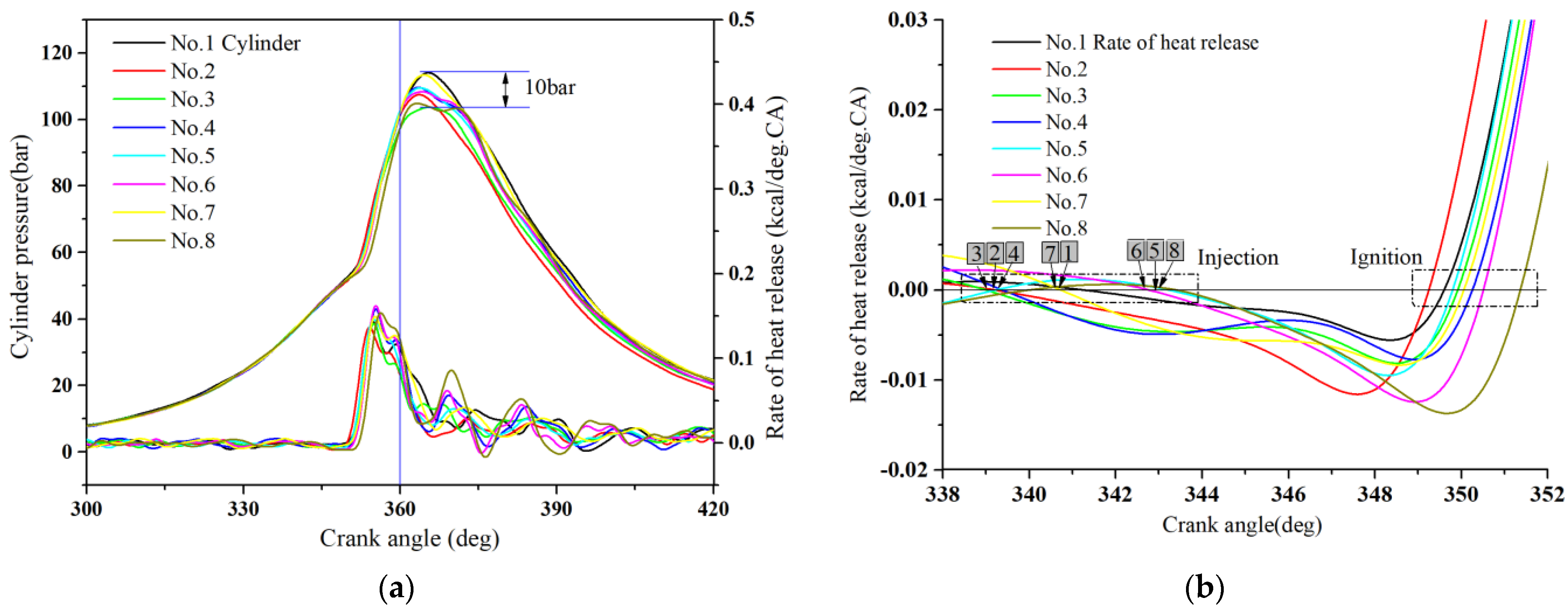
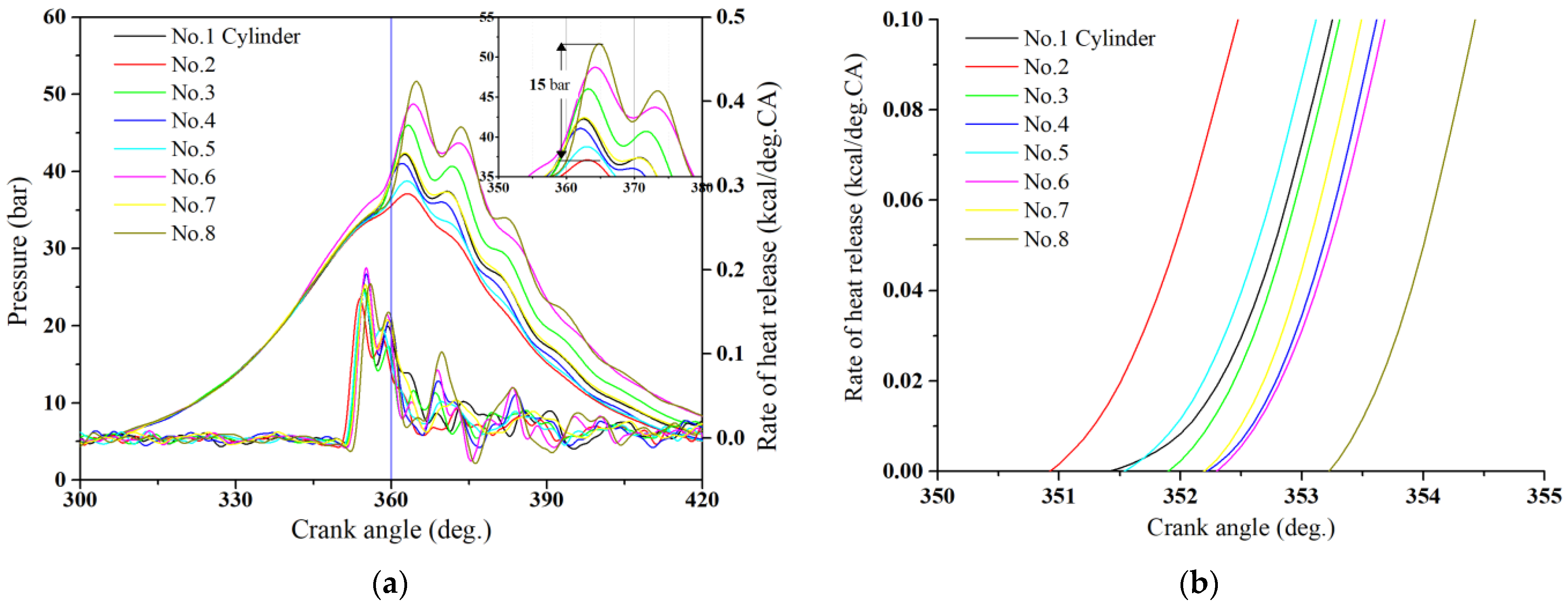


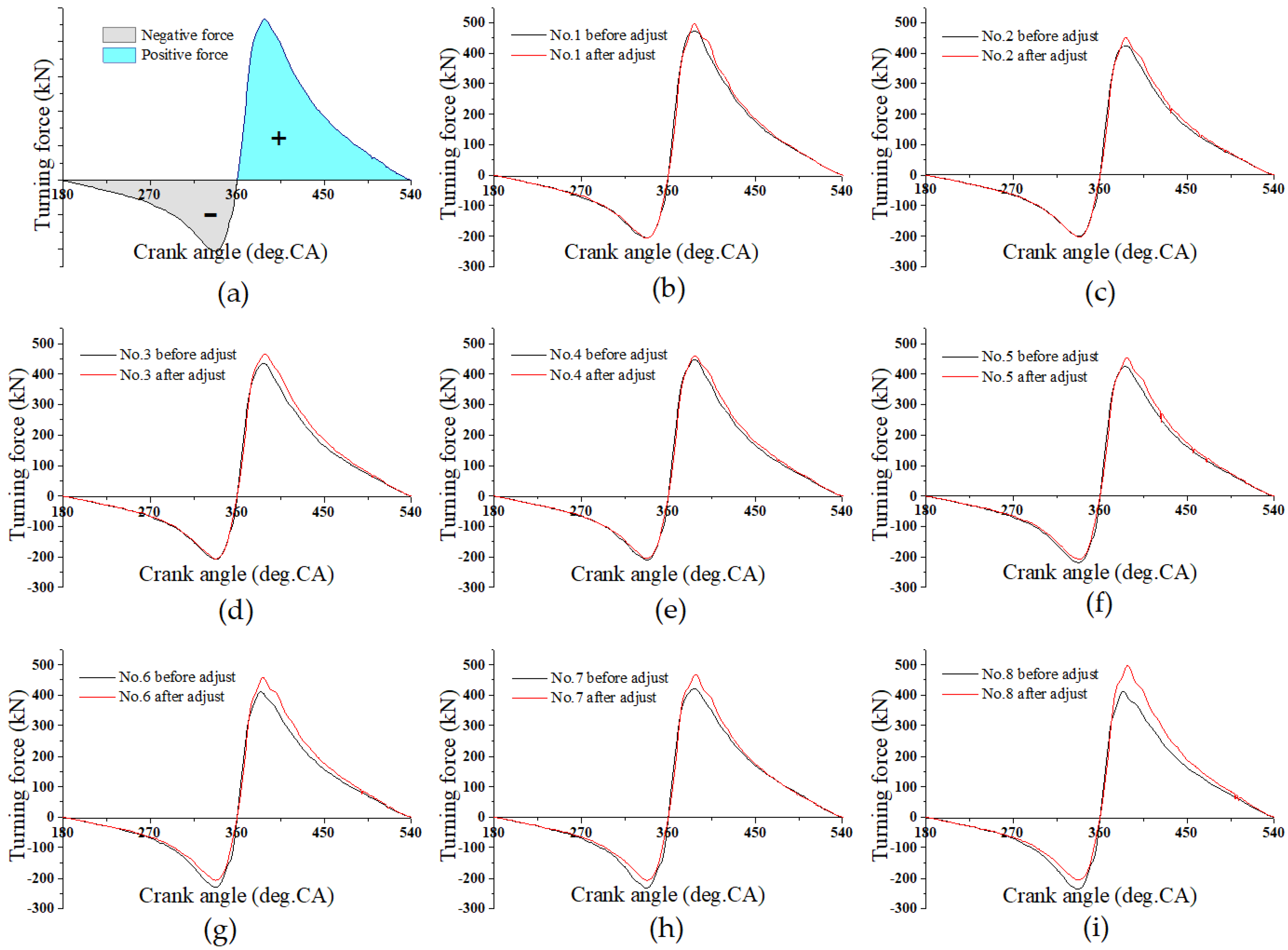
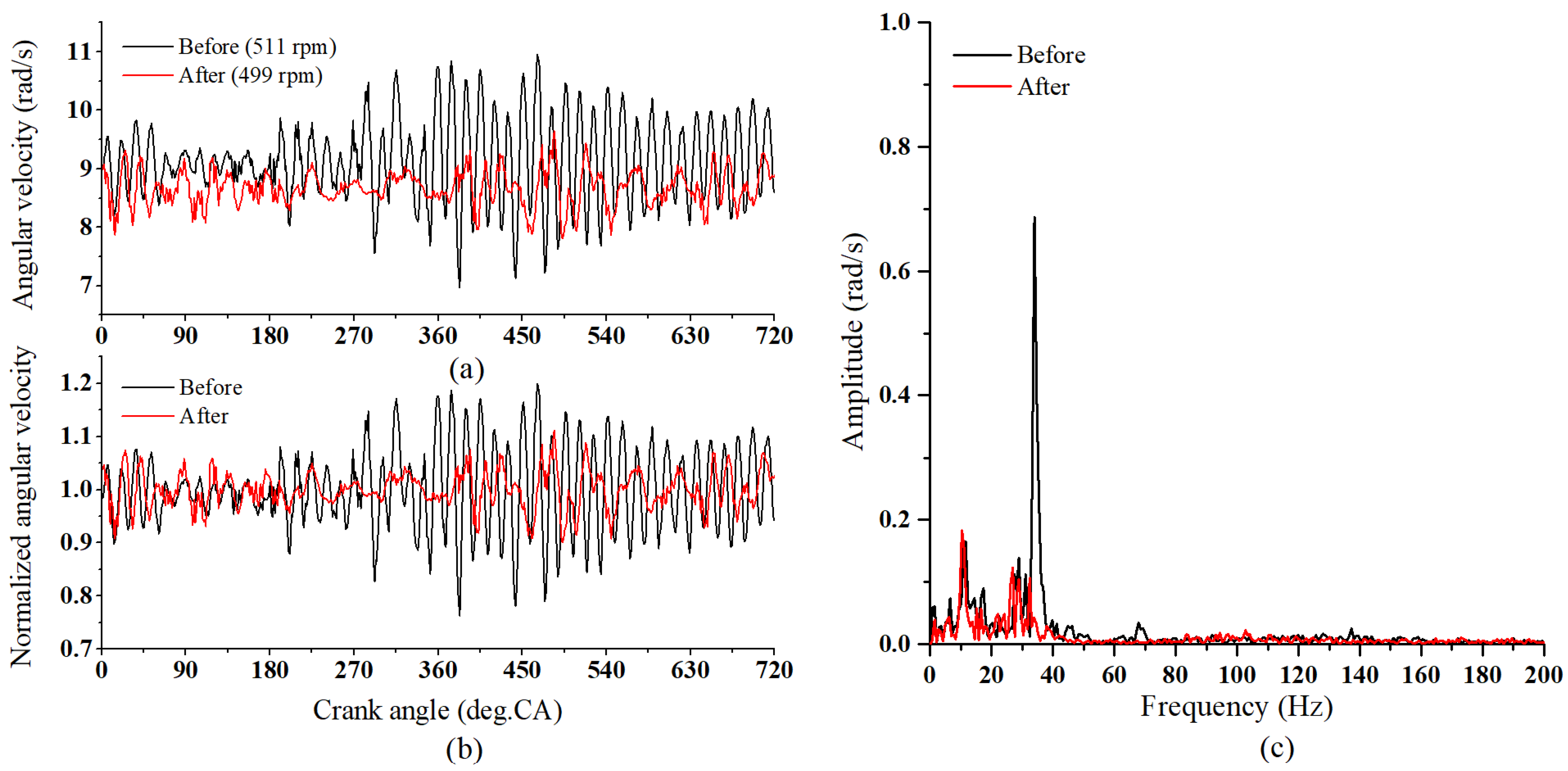
| Model Engine Specification | |
|---|---|
| Type | YANMAR 8N330-EN (4-stroke diesel) |
| Bore/stroke | 330/440 [mm] |
| Cylinders | 8 |
| Fuel injection pump | Spill port type mechanically controlled by camshaft |
| compression ratio | 13.5:1 |
| Firing order | 1-4-7-6-8-5-2-3 |
| Normal rated speed | 620 [rpm] |
| Maximum output | 3310 [kW] |
| Maximum pressure | 12.2 [MPa] |
| Unit | No. 1 | No. 2 | No. 3 | No. 4 | No. 5 | No. 6 | No. 7 | No. 8 | ||
|---|---|---|---|---|---|---|---|---|---|---|
| Before (43% load) | Compression work | kJ | 3.4 | 3.2 | 3.3 | 3.3 | 3.5 | 3.6 | 3.6 | 3.6 |
| Expansion work | 8.1 | 7.3 | 7.5 | 7.6 | 7.3 | 7.1 | 7.5 | 7.2 | ||
| Indicated work | 4.7 | 4.1 | 4.2 | 4.3 | 3.9 | 3.6 | 3.9 | 3.6 | ||
| After (46% load) | Compression work | 3.3 | 3.2 | 3.2 | 3.2 | 3.3 | 3.2 | 3.2 | 3.2 | |
| Expansion work | 8.3 | 7.6 | 8.0 | 7.9 | 7.7 | 7.8 | 7.9 | 8.4 | ||
| Indicated work | 5.0 | 4.4 | 4.8 | 4.7 | 4.4 | 4.6 | 4.7 | 5.1 | ||
Disclaimer/Publisher’s Note: The statements, opinions and data contained in all publications are solely those of the individual author(s) and contributor(s) and not of MDPI and/or the editor(s). MDPI and/or the editor(s) disclaim responsibility for any injury to people or property resulting from any ideas, methods, instructions or products referred to in the content. |
© 2023 by the authors. Licensee MDPI, Basel, Switzerland. This article is an open access article distributed under the terms and conditions of the Creative Commons Attribution (CC BY) license (https://creativecommons.org/licenses/by/4.0/).
Share and Cite
Baek, H.-M.; Jung, G.-S.; Vuong, Q.D.; Lee, J.-U.; Lee, J.-W. Effect of Performance by Excessive Advanced Fuel Injection Timing on Marine Diesel Engine. Appl. Sci. 2023, 13, 9263. https://doi.org/10.3390/app13169263
Baek H-M, Jung G-S, Vuong QD, Lee J-U, Lee J-W. Effect of Performance by Excessive Advanced Fuel Injection Timing on Marine Diesel Engine. Applied Sciences. 2023; 13(16):9263. https://doi.org/10.3390/app13169263
Chicago/Turabian StyleBaek, Hyun-Min, Gyun-Sik Jung, Quang Dao Vuong, Jae-Ung Lee, and Ji-Woong Lee. 2023. "Effect of Performance by Excessive Advanced Fuel Injection Timing on Marine Diesel Engine" Applied Sciences 13, no. 16: 9263. https://doi.org/10.3390/app13169263
APA StyleBaek, H.-M., Jung, G.-S., Vuong, Q. D., Lee, J.-U., & Lee, J.-W. (2023). Effect of Performance by Excessive Advanced Fuel Injection Timing on Marine Diesel Engine. Applied Sciences, 13(16), 9263. https://doi.org/10.3390/app13169263






